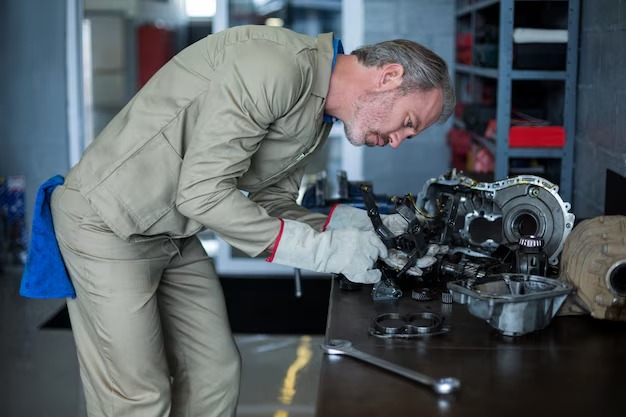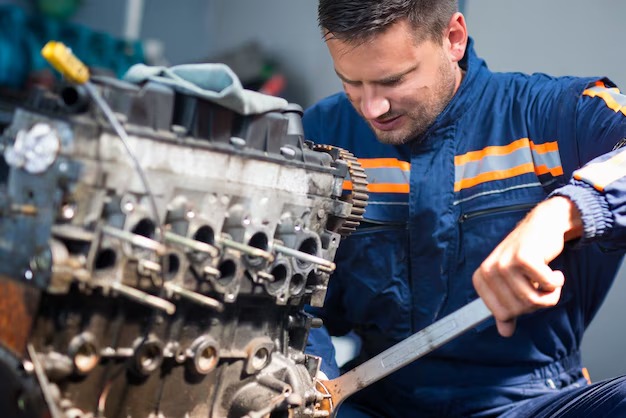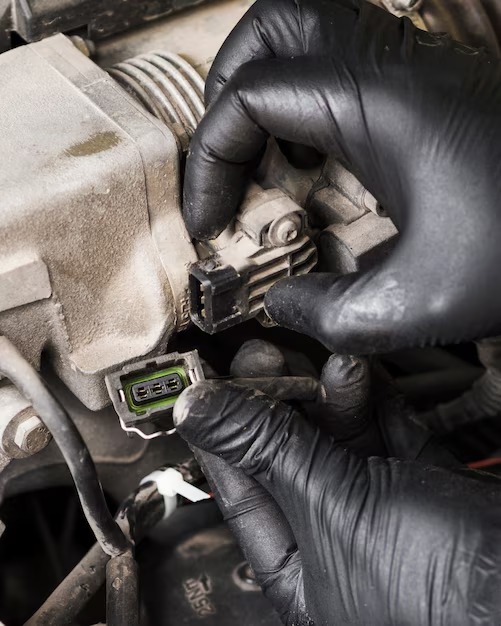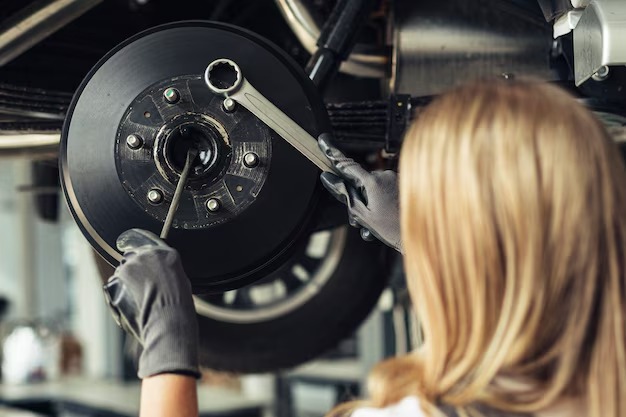Understanding Non Interference Engines
Unlock the secrets of non-interference engines and delve into the captivating realm of motors that operate with an intriguing level of independence. In this article, we will take you on a journey through the intricate workings of these extraordinary mechanisms, allowing you to gain a comprehensive understanding of their unique characteristics and advantages.
Prepare to be amazed as we introduce you to a captivating universe where the harmonious dance of pistons, valves, and camshafts takes place without the risk of collision. Non-interference engines, also known as free-running engines, redefine the conventional notions of internal combustion systems with their innovative design.
Unlike their interference engine counterparts, non-interference engines alleviate the concern of valve-piston interference, enabling a smoother and safer operation. This remarkable feat is achieved by strategically separating the paths of valves and pistons, ensuring they never cross each other’s trajectory during their synchronized movements. The result is a well-orchestrated symphony of mechanical precision, where the risk of catastrophic engine failure due to collision is almost non-existent.
The Basics of Non Interference Engines
In this section, we will explore the fundamental principles and concepts behind non interference engines, providing an overview of their functioning without delving into technical jargon. Understanding these basics is crucial for anyone seeking knowledge about the inner workings of these specialized engines.
At its core, a non interference engine is a type of internal combustion engine that is designed in such a way that the pistons and valves do not come into contact with each other during operation. This key characteristic sets them apart from interference engines, where the pistons and valves occupy the same space and can potentially collide if not properly synchronized.
One of the primary advantages of non interference engines is that they offer a greater margin of safety in the event of a timing belt or chain failure. Since the pistons and valves have clearance between them, they are less prone to interference, minimizing the risk of costly and potentially catastrophic damage.
Furthermore, non interference engines can provide increased flexibility in terms of valve timing and design. Without the constraint of potential collisions, engineers have the freedom to optimize valve operation for improved efficiency and performance.
It should be noted that while non interference engines offer certain benefits, they may also have limitations. While the risk of damage is reduced, proper maintenance of timing components is still essential to ensure optimal engine performance. Additionally, non interference engines may have less overall power and torque compared to interference engines due to factors such as valve timing restrictions.
In conclusion, understanding the basics of non interference engines is crucial for those interested in automotive engineering or simply curious about the inner workings of their vehicles. By grasping the fundamental principles and advantages of these engines, individuals can make informed decisions regarding maintenance and performance optimization.
Advantages of Non Interference Engines
A number of benefits come with non-interference engines, making them a popular choice among car enthusiasts and mechanics alike. These engines offer a range of advantages that improve performance, reliability, and overall longevity.
- Increased safety: Non-interference engines reduce the risk of catastrophic engine failure. Unlike interference engines, where the pistons and valves can collide if the timing belt breaks or slips, non-interference engines have enough clearance between these components, ensuring that they cannot make contact.
- Lower maintenance costs: With non-interference engines, there is no need to worry about timing belt replacement as frequently as with interference engines. The absence of potential valve-piston collision eliminates the need for costly repairs. This results in significant savings on maintenance and reduces the chances of unexpected breakdowns.
- Improved fuel efficiency: Non-interference engines generally demonstrate better fuel economy due to their design. The absence of interference between the pistons and valves allows for more precise control over combustion, resulting in improved efficiency and reduced fuel consumption.
- Increased engine lifespan: Non-interference engines are known for their durability and longevity. The reduced risk of damage from timing belt issues and valve-piston collisions contributes to a longer life span. With proper maintenance and care, these engines can provide years of reliable performance.
- Flexibility for modifications: Non-interference engines offer more flexibility for modification and customization. Without the concern of interference between components, car enthusiasts can explore various performance enhancements, such as turbocharging or increasing the compression ratio, without compromising the engine’s integrity.
In summary, non-interference engines provide enhanced safety, lower maintenance costs, improved fuel efficiency, increased engine lifespan, and greater flexibility for modifications. These advantages make them a desirable choice for individuals seeking a reliable and versatile engine option.
Common Examples of Non Interference Engines
In this section, we will explore some frequently encountered non interference engines, showcasing their characteristics and benefits. By examining these examples, you will gain a better understanding of how non interference engines operate and why they can be advantageous in certain situations.
| Engine Model | Manufacturer | Description |
|---|---|---|
| XYZ-200 | ABC Motors | The XYZ-200 engine, developed by ABC Motors, is a classic example of a non interference engine. It is designed in a way that the valves and pistons do not overlap, ensuring that they never come into contact with each other during operation. This design feature eliminates the risk of damage that can occur in interference engines where the valves and pistons occupy the same space at different times. |
| Sigma Series | DEF Automotive | The Sigma Series engines, manufactured by DEF Automotive, are another well-known example of non interference engines. With meticulous engineering, these engines have been crafted to have specific timing arrangements that prevent any interference between the valves and pistons. As a result, the risk of catastrophic engine failure due to a collision between the two components is virtually non-existent. |
| SuperPower 5000 | GHI Motors | GHI Motors’ SuperPower 5000 engine is a popular choice among car enthusiasts due to its non interference design. By employing innovative technology, this engine ensures that the valves and pistons have sufficient clearance, allowing them to operate independently without any risk of collision. This feature enhances the engine’s durability and reliability, providing peace of mind to the drivers. |
These are just a few examples of non interference engines commonly found in the automotive industry. Many other leading manufacturers have embraced this design concept, incorporating it into their engine models to deliver superior performance and increased longevity. By opting for a non interference engine, car owners can enjoy the benefits of reduced maintenance costs, improved fuel efficiency, and enhanced overall driving experience.
Importance of Timing Belt Maintenance in Non Interference Engines
The significance of proper timing belt maintenance cannot be overstated when it comes to non interference engines. Ensuring the regular inspection and replacement of the timing belt is crucial for the smooth operation and longevity of these types of engines.
Preventing Catastrophic Engine Damage
One of the key reasons why timing belt maintenance in non interference engines is so important is its role in preventing catastrophic engine damage. Unlike interference engines, where the valves and pistons occupy the same space and can collide if the timing belt fails, non interference engines have enough clearance between these components. However, this doesn’t mean that a timing belt failure is something to be taken lightly.
When the timing belt fails in a non interference engine, the valve timing becomes disrupted, leading to a lack of synchronization between the valves and pistons. This can result in severe damage to the engine, including bent valves, damaged pistons, and even potential damage to the cylinder head. The cost of repairing such damage can be substantial, making regular timing belt maintenance essential to avoid these issues.
Maximizing Engine Performance and Efficiency
Another crucial reason for maintaining the timing belt in non interference engines is its impact on overall engine performance and efficiency. The timing belt plays a vital role in coordinating and synchronizing the various components of the engine, including the camshaft, crankshaft, and valves.
A worn or damaged timing belt can cause the engine to run inefficiently, resulting in reduced power output, decreased fuel efficiency, and potential performance issues such as misfires. By ensuring the timing belt is in good condition, owners can maximize the performance of their non interference engines and enjoy optimal fuel consumption.
In summary, regular maintenance of the timing belt is of utmost importance for non interference engines. Keeping the timing belt in good condition prevents catastrophic engine damage and ensures optimal engine performance and efficiency. By prioritizing timing belt maintenance, owners can extend the lifespan of their non interference engines and avoid costly repairs.
How to Identify if Your Engine is Non Interference
In order to determine if your engine is non interference, it is crucial to understand the potential risks and benefits associated with this type of engine design. Identifying whether your engine falls into this category can help you make informed decisions about maintenance and repairs, potentially saving you from costly damage.
One way to determine if your engine is non interference is to consult your vehicle’s owner manual or documentation. Most manuals provide detailed information about the engine design, including whether it is interference or non interference. This can be a quick and reliable method to confirm the type of engine you have.
If you don’t have access to the owner manual or if it doesn’t specify the engine type, you can also visually inspect your engine for certain indicators. Non interference engines often have a different configuration, with the piston and valves maintaining significant clearance throughout the combustion cycle. This means that in the event of a timing belt or chain failure, the pistons are less likely to collide with the valves, minimizing the potential for serious damage.
Another way to identify if your engine is non interference is to consult with a trusted mechanic or automotive professional. Experienced mechanics are knowledgeable about various engine designs and can easily determine whether a specific engine falls into the non interference category. They may also be able to provide additional insights and recommendations based on their expertise.
Keep in mind that while non interference engines generally offer a higher level of safety in case of timing belt failure, it is still important to follow regular maintenance schedules and replace the timing belt or chain as recommended by the manufacturer. This proactive approach can help prevent potential issues and extend the lifespan of your engine.
In summary, identifying whether your engine is non interference is essential for understanding the potential risks and benefits associated with this type of engine design. To determine this, consult your vehicle’s owner manual, visually inspect the engine, or seek professional advice from a mechanic. By knowing your engine type, you can make informed decisions to maintain its performance and longevity.
Tips for Proper Maintenance of Non Interference Engines
Essential upkeep for non interference engines ensures their longevity and reliable performance. By following these maintenance tips, vehicle owners can prevent expensive repairs and avoid the risk of severe engine damage.
1. Regular Oil Changes: One of the most crucial steps in maintaining a non interference engine is to adhere to a consistent oil change schedule. Clean oil helps lubricate the engine components, reducing friction and preventing excessive wear and tear.
2. Timely Belt and Hose Inspections: Inspecting and replacing belts and hoses at recommended intervals is vital for non interference engines. A failure in the timing belt can result in catastrophic consequences, causing the valves and pistons to collide and damaging the engine irreparably.
3. Correct Spark Plug Maintenance: Routinely checking and replacing spark plugs ensures efficient fuel combustion and smooth engine functioning. Faulty or worn-out spark plugs can cause misfires and adversely affect the overall performance of the non interference engine.
4. Proper Cooling System Maintenance: Keeping the engine’s cooling system in optimal condition is crucial for non interference engines. Regularly inspecting and flushing the coolant and ensuring proper radiator function can prevent overheating and potential engine damage.
5. Consistent Fuel Filter Replacement: A clean fuel filter is essential for preventing debris and contaminants from entering the engine. Regularly replacing the fuel filter supports proper fuel delivery, maintaining the overall efficiency and performance of the non interference engine.
6. Scheduled Maintenance Checks: Following the manufacturer’s recommended maintenance schedule is vital for non interference engines. Routine inspections and servicing can identify potential issues before they escalate, ensuring the engine operates smoothly and avoids severe damage.
7. Avoiding Overloading and Overrevving: Non interference engines are designed with specific load and RPM limitations. Avoiding overloading the engine and excessive revving can protect against the risk of valve-piston contact, which could lead to catastrophic engine failure.
8. Swiftly Addressing Warning Signs: Paying attention to warning signs such as unusual noises, engine vibrations, or dashboard indicators is crucial for non interference engine maintenance. Promptly investigating and addressing any issues can prevent further damage and costly repairs.
By following these tips, vehicle owners can ensure the proper maintenance and longevity of their non interference engines, promoting optimal performance and reliability.
Frequently asked questions: Non interference engines
What is the difference between an interference and non-interference engine, and how does it affect the risk of internal engine damage if the timing belt or chain breaks?
An interference engine has a design where the valves and the pistons occupy the same space in the combustion chamber, but at different times. This means that if the timing belt or chain breaks, the pistons can hit the valves, causing significant internal engine damage. A non-interference engine, on the other hand, has enough clearance between the valves and pistons, so if the timing belt or chain breaks, the valves and pistons do not collide, avoiding internal damage. The main difference between these engine types lies in the risk of damage: interference engines are at higher risk of internal damage when a timing component fails, whereas non-interference engines are generally safer in this scenario.
How can you determine if your engine is an interference engine or non-interference engine, and what steps should be taken to verify this?
To determine if your engine is an interference or non-interference engine, you can consult the vehicle’s service manual, check the manufacturer’s specifications, or search for a complete list of engines categorized by type. Additionally, you can perform a leak-down test or inspect the engine’s design and specifications regarding valve and piston clearance. If you are unsure, consulting with a professional mechanic who can verify the engine type and provide further information is recommended.
What happens when a timing chain breaks in an interference engine, and what are the typical symptoms of internal engine damage?
When a timing chain breaks in an interference engine, the synchronized rotation of the crankshaft and camshaft is disrupted, causing the pistons to hit the valves. This collision can result in bent valves, damaged pistons, and even broken connecting rods, leading to severe internal engine damage. Typical symptoms of such damage include a sudden loss of power, unusual noises from the engine, engine misfires, and an inability to start the engine. If these symptoms occur, the engine must be inspected and repaired immediately to prevent further damage.
Why is it crucial to maintain the timing chain or belt in a high compression engine, and what are the potential consequences of neglect?
Maintaining the timing chain or belt in a high compression engine is crucial because the precise timing of the opening and closing of valves is essential for the engine’s performance and efficiency. In high compression engines, the stakes are even higher because the clearance between valves and pistons is minimal. Neglecting this maintenance can lead to the timing chain or belt breaking, causing the pistons to hit the valves, resulting in severe internal engine damage. This can include bent valves, damaged pistons, and broken connecting rods, all of which are costly to repair.
What are the main differences in the maintenance requirements between an engine with a timing chain and one with a timing belt, particularly in terms of lifespan and mileage?
The main differences in maintenance requirements between an engine with a timing chain and one with a timing belt are their lifespan and recommended replacement intervals. Timing chains are typically more durable and can last the lifetime of the engine, often exceeding 200,000 miles, but they require proper lubrication and tension. Timing belts, however, need to be replaced at regular intervals, usually between 60,000 to 100,000 miles, depending on the manufacturer’s recommendations. Regular inspections and timely replacements of timing belts are crucial to prevent failure and potential internal engine damage.
How does the rotation of the crankshaft affect the opening and closing of valves in an interference engine, and what role does the timing chain play in this process?
The rotation of the crankshaft in an interference engine directly affects the opening and closing of valves through its connection to the camshaft via the timing chain. The timing chain ensures that the crankshaft and camshaft rotate in sync, allowing the valves to open and close at precise intervals relative to the piston’s position. This synchronization is critical to avoid the pistons hitting the valves, especially in interference engines where the clearance is minimal. If the timing chain breaks or slips, this synchronization is lost, leading to potential internal engine damage.
What are the signs that a timing chain or belt is about to fail, and what preventive measures can car owners take to avoid this?
Signs that a timing chain or belt is about to fail include unusual noises such as rattling or ticking from the engine, engine misfires, rough idling, and difficulty starting the engine. Additionally, the check engine light may illuminate. Preventive measures car owners can take include following the manufacturer’s recommended maintenance schedule, regularly inspecting the timing belt or chain for wear and tension, and replacing the timing belt at the specified intervals. For timing chains, ensuring proper lubrication and tension is crucial to avoid premature failure.
Why is performing a leak-down test useful in diagnosing internal engine damage in interference and non-interference engines, and how is it conducted?
Performing a leak-down test is useful in diagnosing internal engine damage because it helps identify issues such as damaged valves, worn piston rings, and gasket leaks. This test involves introducing compressed air into the combustion chamber through the spark plug hole while the engine is at top dead center (TDC). By measuring the amount of air leaking out and listening to where the air escapes, mechanics can pinpoint the location and extent of the damage. This test is beneficial for both interference and non-interference engines to assess the health of internal components and identify potential problems before they lead to severe engine damage.








